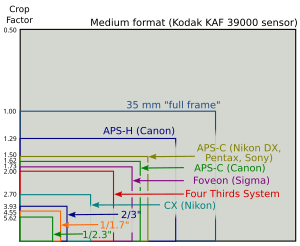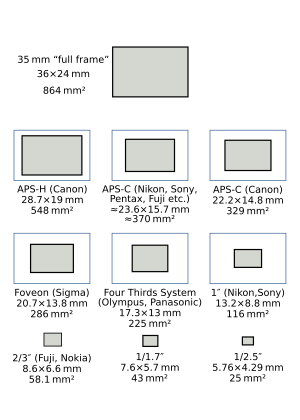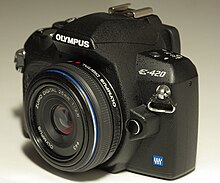What Is A 4/3 Camera

The Four Thirds Organization is a standard created by Olympus and Eastman Kodak for digital single-lens reflex photographic camera (DSLR) and mirrorless camera blueprint and development.[ane]
The system provides a standard that, with digital cameras and lenses available from multiple manufacturers, allows for the interchange of lenses and bodies from dissimilar manufacturers. U.S. Patent 6,910,814 seems to cover the standard. Proponents depict information technology as an open standard, merely companies may apply it merely nether a not-disclosure understanding.[2]
Unlike older single-lens reflex (SLR) systems, 4 Thirds was designed from the start to be entirely digital. Many lenses are extensively computerised, to the signal that Olympus offers firmware updates for many of them. Lens pattern has been tailored to the requirements of digital sensors, near notably through telecentric designs. The size of the sensor is significantly smaller than for most DSLRs and this implies that lenses, especially telephoto lenses, can exist smaller. For example, a Four Thirds lens with a 300 mm focal length would cover about the aforementioned angle of view as a 600 mm focal length lens for the 35 mm film standard, and is correspondingly more compact. Thus, the Four Thirds System has ingather cistron (focal length multiplier) of nearly 2, and while this enables longer focal length for greater magnification, it does not necessarily aid the industry of wide bending lenses.
The image sensor format, between those of larger SLRs and smaller point-and-shoot meaty digital cameras, yields intermediate levels of cost, performance, and convenience.
Sensor size and aspect ratio [edit]

Cartoon showing the relative sizes of sensors used in most current digital cameras, including Four Thirds Organisation
The name of the organization stems from the size of the epitome sensor used in the cameras, which is usually referred to every bit a 4/iii" type or 4/three type sensor. The common inch-based sizing system is derived from vacuum epitome-sensing video camera tubes, which are at present obsolete. The imaging area of a Four Thirds sensor is equal to that of a video camera tube of 4/iii inch diameter.[3]

Sizes of the sensors used in most current digital cameras relative to a standard 35mm frame
The usual size of the sensor is eighteen mm × thirteen.v mm (22.5 mm diagonal), with an imaging expanse of 17.3 mm × 13.0 mm (21.63 mm diagonal).[iii] [iv] The sensor's area is nearly xxx–40% smaller than APS-C sensors used in most other DSLRs, but all the same around 9 times larger than the i/2.five" sensors typically used in compact digital cameras. Incidentally, the imaging area of a Four Thirds sensor is nigh identical to that of 110 film.
The emphasis on the 4:3 image aspect ratio sets Four Thirds apart from other DSLR systems, which usually attach to the iii:2 aspect ratio of the traditional 35mm format. However, the standard simply specifies the sensor diagonal, thus 4 Thirds cameras using the standard 3:two aspect ratio would be possible;[5] notably newer Panasonic Micro Iv Thirds models even offer shooting at multiple aspect ratios while maintaining the same image diagonal. For instance, the Panasonic GH1 uses a multi-aspect sensor designed to maximize apply of the epitome circle at 4:3, three:2, and 16:ix; each ratio having a diagonal of 22.five mm.[6]
Sensor aspect ratio influences lens design. For example, many lenses designed past Olympus for the Iv Thirds System contain internal rectangular baffles or permanently mounted "petal" lens hoods that optimise their performance for the 4:three aspect ratio.[ citation needed ]
In an interview John Knaur, a Senior Product Manager at Olympus, stated that "The FourThirds refers to both the size of the imager and the aspect ratio of the sensor".[7] He likewise pointed out the similarities between 4:three and the standard printing size of 8×10 also equally medium format 6×four.five and 6×7 cameras, thus helping explain Olympus' rationale on choosing 4:3 rather than 3:two.
Advantages, disadvantages and other considerations [edit]
Advantages [edit]
- The smaller sensor size makes possible smaller and lighter camera bodies and lenses. In particular, the Iv-Thirds system allows the evolution of compact, large discontinuity lenses. Respective lenses get larger, heavier and more expensive when designed for larger sensor formats.

- Telecentric optical path ways that low-cal hit the sensor is traveling closer to perpendicular to the sensor, resulting in brighter corners, and improved off-center resolution, specially on wide bending lenses.
- Because the flange focal distance is significantly shorter than those on Canon FD, Canon EF, Nikon F and Pentax Thousand, lenses for many other SLR types including the former Olympus OM Organization can be fitted to Four Thirds cameras with simple mechanical adapter rings. Such mechanical adapter rings typically require transmission setting of focus and aperture.[9]
Disadvantages [edit]
- Compared to a larger sensor with equivalent pixel count, a Four Thirds sensor gathers unduly less low-cal per pixel. Non only are the individual photosites smaller, but each loses more of its full area to support circuitry and edge shading than a larger photosite would. With less captured lite to piece of work with, each photosite requires additional amplification, with associated higher racket every bit well as reduced dynamic range. A telecentric lens design tin mitigate this trouble, only the sensor remains more sensitive to the bending of incoming lite, and has more pronounced prototype corner low-cal falloff.
- The resolution of a sensor is often measured equally the total sensor pixel count in megapixels, and this is ofttimes a primary decision-making gene in choosing a camera. Smaller sensors are tougher to manufacture with the aforementioned pixel density as larger sensors, and identify a greater demand on optics, since a lens must achieve greater absolute resolving power to produce an adequate picture on a smaller sensor, compared to a larger sensor of the same pixel resolution. A smaller pixel active area reduces the averaging outcome and allows a meliorate sampling of high spatial frequencies, mitigating this problem.[10]
- To get the aforementioned angle of view as with a larger sensor, the focal length of the lens used with a Four Thirds sensor needs to exist shorter. Withal, to get the same depth of field and calorie-free gathering capability as with a larger sensor, the lens aperture needs to be kept constant. In other words, the focal ratio of the lens must be smaller on the 4 Thirds system to requite the same depth of field[11] and image noise. Since it is more difficult to produce faster lenses (lenses with smaller focal ratios), it can be difficult or impossible to find a lens that produces equally shallow a depth of field, and gathers as much light, every bit an equivalent lens on larger formats. For instance, a 35mm "total-frame" DSLR can lucifer the depth of field of a Iv Thirds camera by closing downwards the aperture by two stops; but information technology may exist more difficult or incommunicable for a Four Thirds Organization to match the shallow depth of field of a 35mm camera using a fast lens.
Differences [edit]
- Nearly Four Thirds cameras (notably those manufactured by Olympus) use an attribute ratio of four:three rather than 3:2; newer models offering cropping to iii:two, merely this results in a reduced image diagonal (i.due east., the effective crop factor is then two.08).[12]
Four Thirds System companies [edit]
As of the 2006 Photo Marketing Association Almanac Convention and Trade Show, the Four Thirds consortium consisted the post-obit companies:
- Fuji
- Kodak
- Leica
- Olympus
- Panasonic
- Sanyo
- Sigma
This does not imply a delivery to end user products past each visitor. Historically, only Leica, Olympus, and Panasonic have produced bodies. Olympus and Leica/Panasonic accept made dedicated 4 Thirds lenses, and Sigma makes adjusted versions of their "DC" lenses for APS-C format DSLRs. Kodak once sold sensors to Olympus for use in their Four Thirds bodies, just the newer Olympus Four Thirds cameras used Panasonic sensors.
Four Thirds System cameras [edit]
The majority of Four Thirds System cameras and 4 Thirds lenses are made by Olympus. Many Iv Thirds cameras utilise "sensor-shift" in-torso image stabilization, making the need for epitome stabilization engineering science in its lenses unnecessary. All Four Thirds cameras too incorporate an automatic sensor cleaning device, in which a sparse drinking glass filter in front of the sensor vibrates at 30 kHz, causing dust to fall off and attach to a piece of sticky material below. Olympus' E-organisation photographic camera bodies are noted for their inclusion of a broad range of firmware-level features and customization, practiced JPEG engine, and compact size. Because of the smaller format of Four Thirds, the viewfinders tend to be smaller than on comparable cameras.[thirteen] [14]
Manufacture of Four Thirds cameras came to an end afterwards the introduction of the mirrorless Micro Iv Thirds format. Discontinued models include:
- Leica Digilux three
- Olympus E-1
- Olympus E-three
- Olympus E-5
- Olympus East-xxx
- Olympus East-300
- Olympus Due east-330
- Olympus East-400
- Olympus E-410
- Olympus East-420
- Olympus E-450
- Olympus Due east-500
- Olympus E-510
- Olympus E-520
- Olympus E-600
- Olympus E-620
- Panasonic Lumix DMC-L1
- Panasonic Lumix DMC-L10
Four Thirds Organization lenses [edit]

4 lenses for the Four Thirds System. From left to right, three Olympus zooms (40–150mm, eleven–22mm and xiv–54mm) and a Sigma prime (30mm).
The Four Thirds lens mount is specified to be a bayonet type with a flange focal distance of 38.67 mm.
In that location are currently around iii dozen lenses for the Four Thirds System standard.[fifteen]
Before announcing that it would stop production of Four Thirds lenses in early 2017,[16] Olympus produced about 20 lenses for the Four Thirds Arrangement under their "Zuiko Digital" brand. They are divided into iii grades — Standard, High Grade and Super High Course. High Form lenses have faster maximum apertures, but are significantly more expensive and larger, and the Super High Grade zooms take abiding maximum discontinuity over the full zoom range; all but the Standard class are weather-sealed. Lenses within each grade encompass the range from broad-angle to super telephoto.[17] [18] The Zuiko Digital lenses are well regarded for their consistently good eyes.[19] The following table lists all Zuiko Digital lenses available at the time Olympus stopped 4 Thirds production:[20]
| Wide angle | Standard | Telephoto | Super telephoto | Special-purpose | |
|---|---|---|---|---|---|
| Standard | 9–xviiif/iv–five.6 | fourteen–42f/iii.5–5.6 25f/2.8 "pancake" | forty–150f/four–five.vi | lxx–300f/4–v.vi macro | 35f/3.v macro 18–180f/3.5-six.3 superzoom |
| High Grade | 11–22f/2.8–3.5 | 12–60f/2.8–4 xiv–54f/2.8–3.5 II | 50–200f/two.8–iii.5 SWD | lf/2 macro 8f/three.5 fisheye | |
| Super High Grade | 7–fourteenf/4 | 14–35f/two | 35–100f/2 150f/2 | 90–250f/2.viii 300f/two.8 | |
Olympus also made 1.4× and 2× teleconverters and an electronically coupled extension tube.
Sigma has adapted thirteen lenses for the Four Thirds System, ranging from 10 mm to 800 mm, including several for which no equivalent exists: the fast primes (xxx mm f/1.four and 50 mm f/1.4) and farthermost telephoto (300–800 mm f/v.6). Every bit of 2014 all Sigma lenses for the Four Thirds System accept been discontinued.
Leica has designed 4 lenses for the Four Thirds System: fast and slow normal zooms and a 14–150 mm super-zoom, all with Panasonic's image stabilization system, and an unstabilized f/1.iv 25 mm prime. These are manufactured and sold by Panasonic.
An official listing of available lenses can exist found on Four-Thirds.org web site.[21]
As for the system itself, information technology was silently discontinued in favor of the Micro Iv Thirds Arrangement.
Micro Four Thirds System [edit]

Concept Micro Four Thirds camera past Olympus
In August 2008, Olympus and Panasonic introduced a new format, Micro Four Thirds.
The new system uses the aforementioned sensor, but removes the mirror box from the camera blueprint. A live preview is shown on either the camera's main liquid-crystal brandish or via an electronic viewfinder, equally in digital compact cameras. Autofocus may be accomplished via a contrast detection process using the main imager, again similar to digital meaty cameras. Some Olympus manufactured photographic camera bodies also characteristic stage detection auto focus built into the sensor. The goal of the new arrangement was to allow for even smaller cameras, competing directly with higher-end signal-and-shoot compact digital cameras and DSLRs. The smaller flange focal distance allows for more compact normal and broad angle lenses. Information technology besides facilitates the utilise, with an adapter, of lenses based on other mounting systems, including many manual focus lenses from the seventies and eighties.
In particular, Four Thirds lenses can be used on Micro Four Thirds bodies with an adapter; however, "all of the functions of the Micro Four Thirds System may not e'er be available."[22]
Run across also [edit]
- Lenses for SLR and DSLR cameras
- Lens mountain — list of lens mounts
- Video camera tube#Size, origin of 4/3 inch sensor measurement
References [edit]
- ^ "Kodak and Olympus bring together forces". DPReview.com. DPReview.com. 2001-02-13. Retrieved 2007-11-07 .
- ^ "Benefits". Four Thirds Consortium. Retrieved 2008-12-10 .
Details of the Four Thirds System standard are available to camera equipment manufacturers and industry organizations on an NDA basis. Full specifications cannot exist provided to individuals or other educational/research entities.
- ^ a b "No more compromises: The Iv Thirds Standard". Olympus. Europe. Archived from the original on 2011-07-14. Retrieved 2009-04-17 .
- ^ "The Four Thirds Standard". Four Thirds Consortium. 2008. Archived from the original on 2009-03-07. Retrieved 2009-04-17 .
- ^ "Four Thirds Standard" (whitepaper). Four Thirds Consortium. 2009. Retrieved 2009-10-09 .
- ^ Utpott, Björn, G1 sensor vs GH1 sensor (JPEG diagram), PBase .
- ^ Knaur, John (October 1, 2002), Interview, A Digital Eye, archived from the original on 2002-12-05 .
- ^ Olympus E400 Digital Camera Review, Permit's go digital .
- ^ "OMs on E1", Cornucopia, Biofos .
- ^ Full Frame Sensor vs Crop Sensor – Which is Correct For Yous?, Digital Photography School .
- ^ "Depth of Field Equations". world wide web.dofmaster.com . Retrieved 12 April 2018.
- ^ "Specs - Lumix Thou Digital Camera: DMC-GX7| Panasonic Australia". Retrieved 2015-08-28 .
- ^ "DPReview E-30 conclusions page". 2009-04-09.
- ^ "DPReview E-510 review". 2009-04-09.
- ^ Wrotniak, Lens list .
- ^ Butler, Richard (March 10, 2017). "In memoriam: Olympus brings downwardly the curtain on the legacy 4 Thirds system". Digital Photography Review . Retrieved March 16, 2017.
- ^ "Olympus E-System Zuiko Digital Interchangeable Lens Roadmap" (PDF). United kingdom of great britain and northern ireland: Olympus. Archived from the original (PDF) on 2007-10-15. Retrieved 2007-xi-29 .
- ^ "Olympus Lens Tests". SLRgear.
- ^ "Olympus Zuiko 12–60mm ane:ii.8–ane:4 lens review". DPReview.
- ^ "Lens list". Asia: Olympus. Retrieved 2009-08-twenty .
- ^ Lens list, Four Thirds .
- ^ Micro Iv Thirds Official benefits listing.
External links [edit]
- Official Four Thirds Arrangement site
- Four Thirds The states patent 6,910,814; PDF version (1.vii MiB)
- Andrzej Wrotniak'southward pages about the Iv Thirds Organization — includes a consummate lens listing
- Four Thirds User — independent site and user-community dedicated to the Four Thirds Organisation, including Micro Iv Thirds
Source: https://en.wikipedia.org/wiki/Four_Thirds_system
Posted by: lozathatrated.blogspot.com


0 Response to "What Is A 4/3 Camera"
Post a Comment